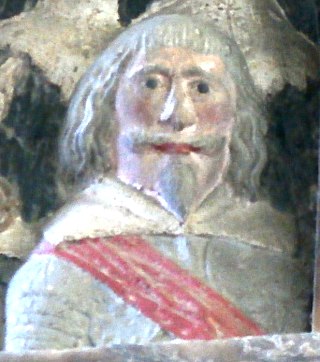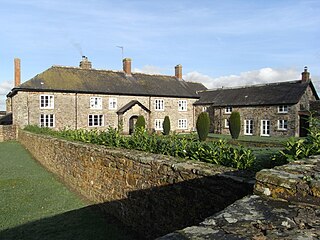
Meavy is a small village, civil parish and former manor in the English county of Devon. Meavy forms part of the district of West Devon. It lies a mile or so east of Yelverton. The River Meavy runs near the village. For administrative purposes the parish is grouped with the parishes of Sheepstor and Walkhampton to form Burrator Parish Council, and for electoral purposes it is grouped with the same two parishes to form Burrator Ward.

Sir Richard Strode of Newnham, Plympton St Mary, Devon and of Chalmington in Dorset, was a member of the Devonshire gentry who served as MP for Bere Alston in 1604, Bridport in 1626 and for Plympton Erle in 1640. He was by religion a puritan and towards the end of his life a baptist. During the Civil War he was a parliamentarian and raised a force of 3,000 dragoons.

Sir William Strode of Newnham, Plympton St Mary, Devon, was a member of the Devonshire gentry and twice served as MP for his family's pocket borough of Plympton Erle, in 1660 and 1661–1676.

Sir William Strode (1562–1637) of Newnham in the parish of Plympton St Mary, Devon, England, was a member of the Devon landed gentry, a military engineer and seven times a Member of Parliament elected for Devon in 1597 and 1624, for Plympton Erle in 1601, 1604, 1621 and 1625, and for Plymouth in 1614. He was High Sheriff of Devon from 1593 to 1594 and was knighted in 1598. In 1599 he was appointed Deputy Lieutenant of Devon. There is a monument to him in the parish church of Plympton St Mary.

Sir John III Chichester of Hall was member of parliament for Lostwithiel in Cornwall in 1624.

Bradfield House is a Grade I listed country house situated in the parish of Uffculme, Devon, England, 2 miles (3.2 km) south-west of the village of Uffculme.

Hall is a large estate within the parish and former manor of Bishop's Tawton, Devon. It was for several centuries the seat of a younger branch of the prominent and ancient North Devon family of Chichester of Raleigh, near Barnstaple. The mansion house is situated about 2 miles south-east of the village of Bishop's Tawton and 4 miles south-east of Barnstaple, and sits on a south facing slope of the valley of the River Taw, overlooking the river towards the village of Atherington. The house and about 2,500 acres of surrounding land continues today to be owned and occupied by descendants, via a female line, of the Chichester family. The present Grade II* listed neo-Jacobean house was built by Robert Chichester between 1844 and 1847 and replaced an earlier building. Near the house to the south at the crossroads of Herner the Chichester family erected in the 1880s a private chapel of ease which contains mediaeval woodwork saved from the demolished Old Guildhall in Barnstaple.

Brightley was historically the principal secondary estate within the parish and former manor of Chittlehampton in the county of Devon, England, situated about 2 1/4 miles south-west of the church and on a hillside above the River Taw. From the early 16th century to 1715 it was the seat of the Giffard family, whose mansion house occupied the moated site immediately to the west of the present large farmhouse known as Brightley Barton, a Grade II listed building which incorporates some elements of the earlier house. It is not to be confused with the 12th-century Brightley Priory near Okehampton.

The Manor of Molland was a medieval manor in North Devon, England. It was largely co-terminous with the existing parish of Molland, in which is situated the village of Molland. More accurately it consisted from the earliest times of two separate manors, held from separate overlords, later known as Molland-Bottreaux and Molland-Champson.

Newnham Park is an historic estate in the civil parish of Sparkwell, Devon, UK. It was known as Loughtor until about 1700 when the ancient Strode family, long seated at Newnham, about 1 mile south-east of the manor house of Loughtor, abandoned Newnham and moved their residence to Loughtor where they built a new mansion house which they renamed "Newnham Park". In 2014 the mansion house with an estate of about 1,550 acres is still owned by a descendant of the Courtenay and Strode families which held the estate from the 15th century, and which were well established in the county of Devon long before that time. In 2014 part of the estate is operated as a commercial clay-pigeon shooting ground.

Ash in the parish of Musbury in the county of Devon is an historic estate, long the residence of the ancient Drake family, the heir of which remarkably was always called John, only one excepted, for ten generations. It was formerly believed to have been the birthplace of John Churchill, 1st Duke of Marlborough (1650–1722), whose mother was Elizabeth Drake, but was in fact probably in ruins at the time of his birth. The future Duke was however baptised in 1650 in the Chapel at Ash, which had been licensed by the Bishop of Exeter in 1387. Ash was "burnt and demolished" during the Civil War and "lay long in ruins" during which time the family moved one mile away to Trill, Axminster. John Drake (1625–1669), the wartime occupant who had suffered so greatly for the Royalist cause received some recompense at the end of the troubles by being created a baronet by King Charles II on the Restoration of the Monarchy in 1660. Ash was rebuilt "to a greater perfection than it was of before" by Sir John Drake, 2nd Baronet (1647–1684). The last in the male line was Sir William Drake, 6th Baronet, who died without children and bequeathed all his estates to his widow Anne Williams, who remarried to George Speke, MP, and had by him a daughter Anne Speke, who brought the Drake estates, including Ash and the advowson of Musbury, to her husband Frederick North, 2nd Earl of Guilford (1732–1792), who sold them piece-meal to various persons. Ash House survives today as a grade II* listed private residence in much the same form as depicted by Swete in 1795.

Whympston in the parish of Modbury in Devon, England, was a historic manor that belonged to the Fortescue family.

Creedy is an historic estate in the parish of Sandford, near Crediton in Devon. It is named from its location on the west side of the River Creedy. It was the seat of the Davie family from about 1600 until the late 20th century. The mansion house on the estate has been called at various times New House, Creedy House, and as presently, Creedy Park. It was first built in about 1600, rebuilt in 1846, burnt down in 1915 and rebuilt 1916–21. It is surrounded by a large park, the boundary of which is enclosed by a stone and brick wall several miles long.

Warleigh is a historic estate within the parish of Bickleigh in Devon, about 6 miles from Plymouth. Warleigh House, the manor house of the manor of Tamerton Foliot is situated one mile west of that village on the south-east bank of the River Tavy where it joins the River Tamar. It was remodelled in about 1830 in the Gothic style by John Foulston and has been listed Grade II* on the National Heritage List for England since 1960.

Lyneham in the parish of Yealmpton in Devon, is an historic estate. The surviving grand mansion house known as Lyneham House is a grade I listed building. It was built c.1699-1703 by Sir Courtenay Croker, MP for Plympton Morice in 1699. A drawing of Lyneham House dated 1716 by Edmund Prideaux (1693–1745) of Prideaux Place, Padstow, Cornwall, survives at Prideaux Place. It shows formal gardens in front with flanking pavilions and an orangery.

Roger Wyck of Bindon in the parish of Axmouth in Devon, was a Member of Parliament for Plympton Erle in 1413.

Painsford is an historic estate in the parish of Ashprington in Devon.

Spridleston is an historic manor in the parish of Brixton in Devon, England, long a seat of a branch of the prominent and widespread Fortescue family. The ancient manor house does not survive, but it is believed to have occupied the site of the present Spriddlestone Barton, a small Georgian stuccoed house a few hundred yards from the larger Spriddlestone House, also a Georgian stuccoed house, both centred on the hamlet of Spriddlestone and near Higher Spriddlestone Farm.

The manor of Haccombe was a historic manor in the small parish of Haccombe, near the town of Newton Abbot, Devon, England. It was the seat of important branches of the Courtenay and Carew families.

Richard Strode, of Newnham, in the parish of Plympton St Mary in Devon, was an English Member of Parliament for Plympton Erle in 1553 and 1559. He later served as escheator for Devon and Cornwall from 1565–1566.






























